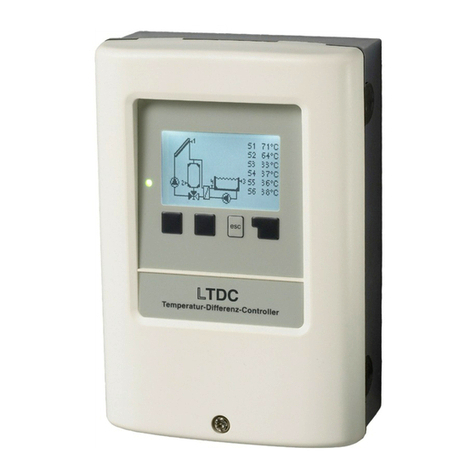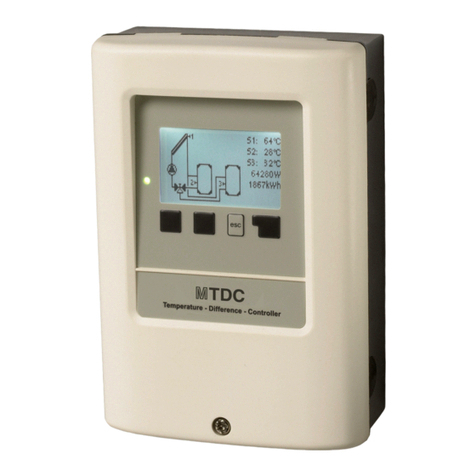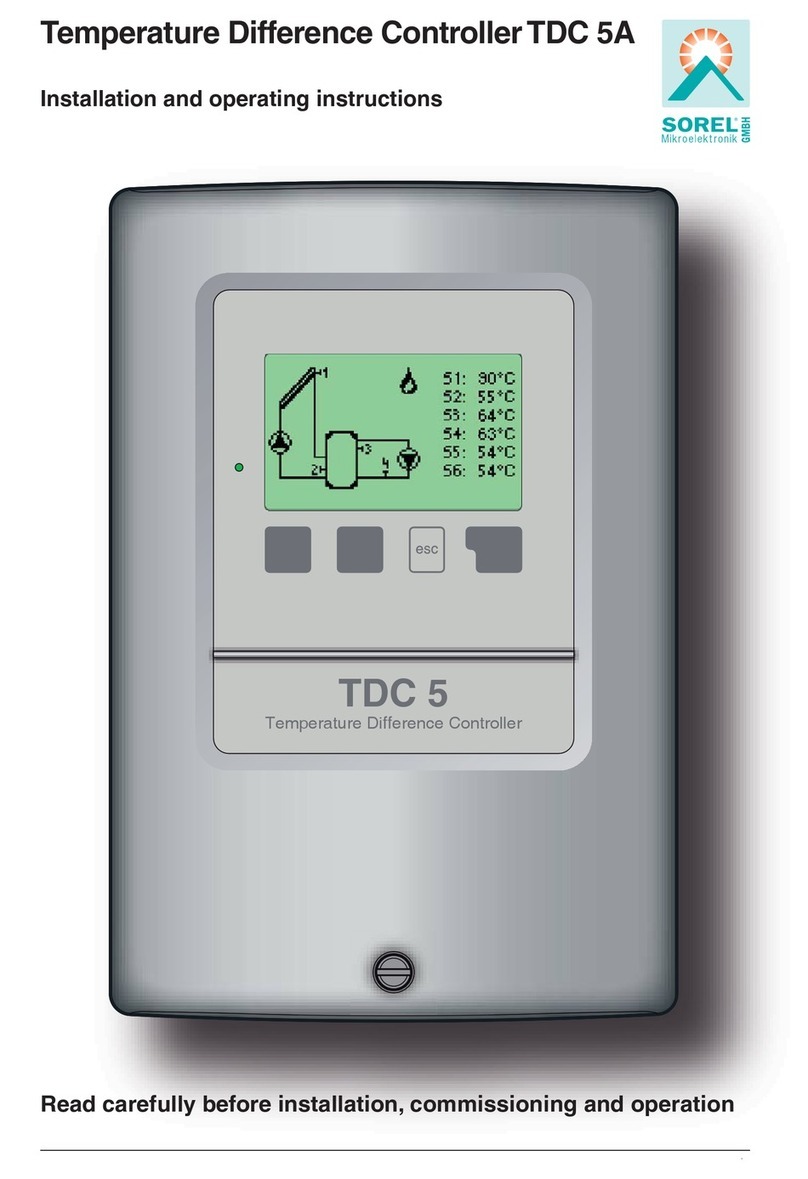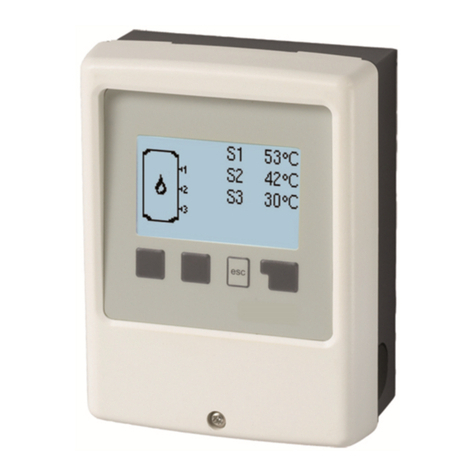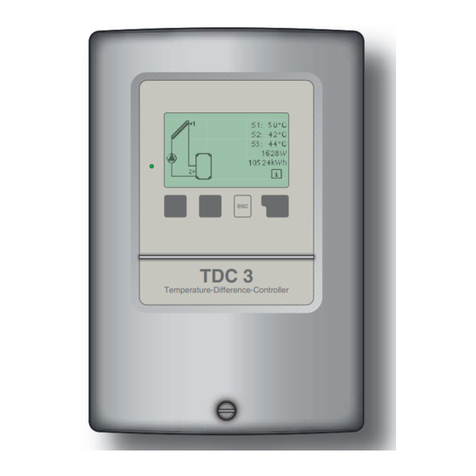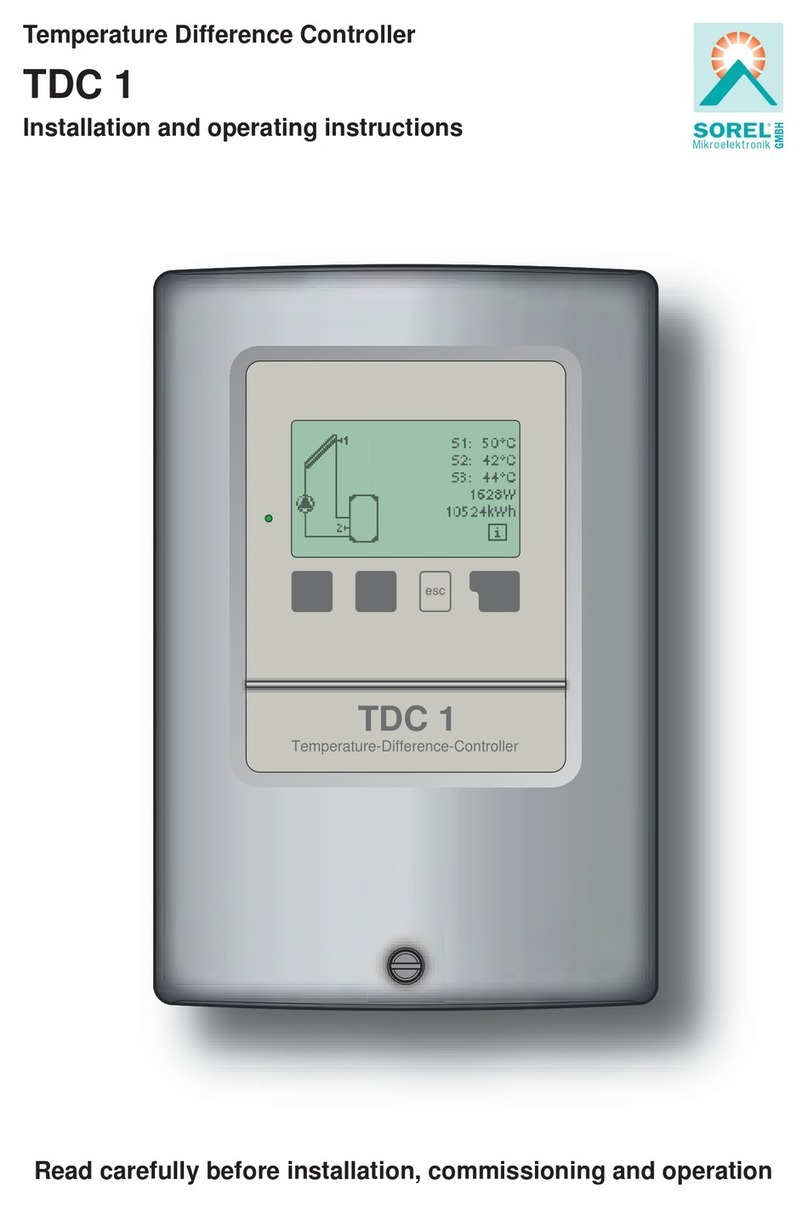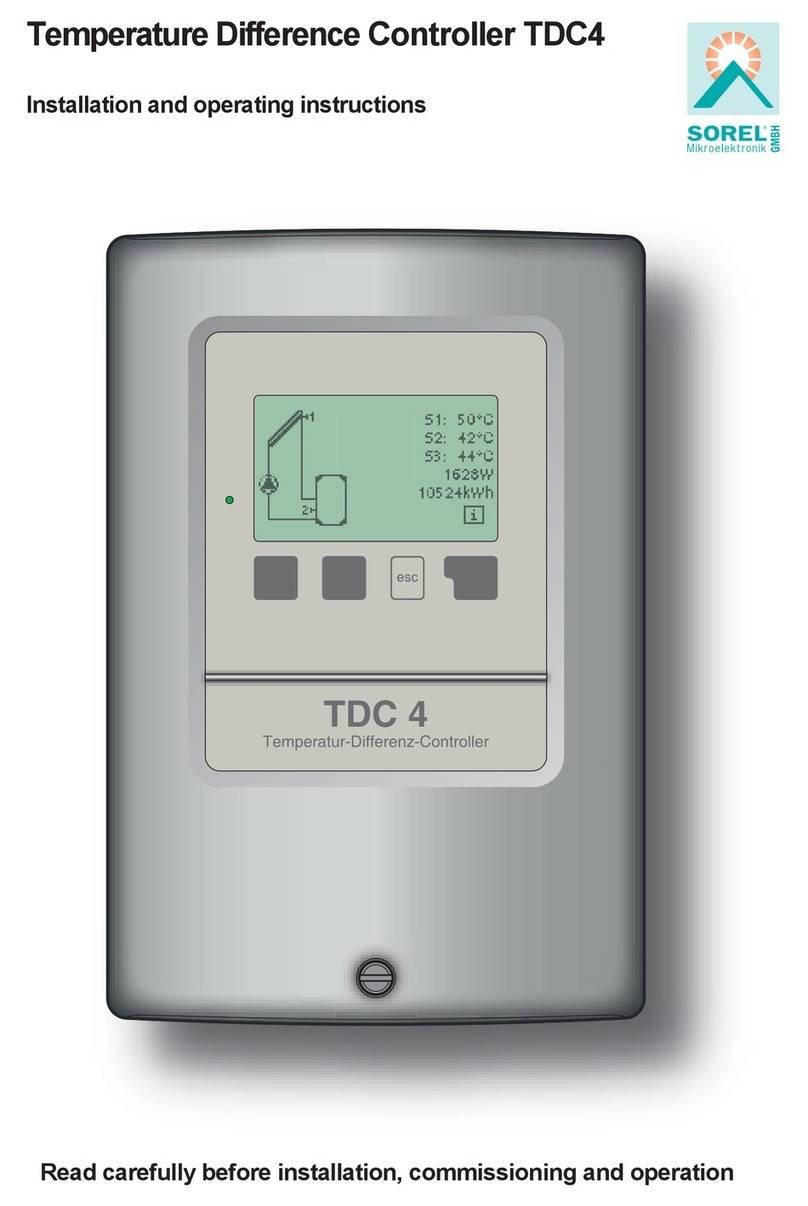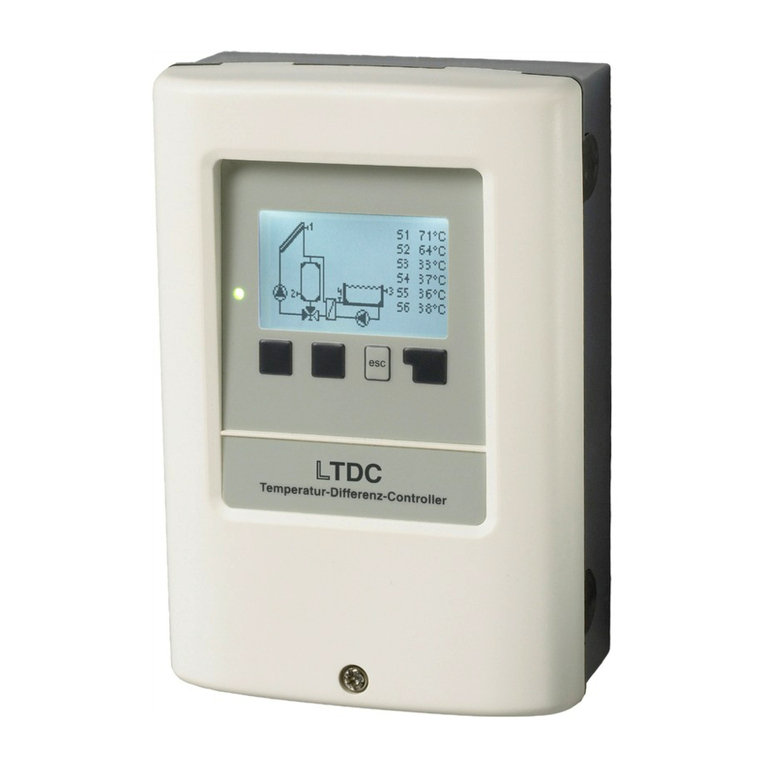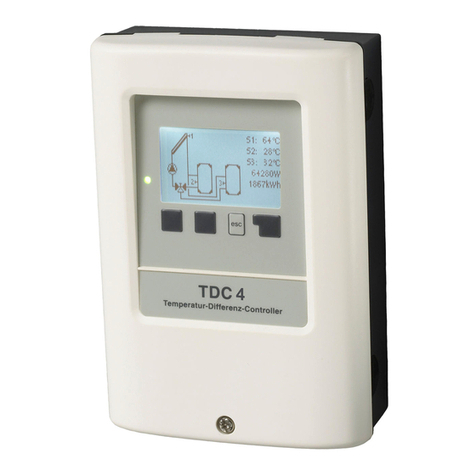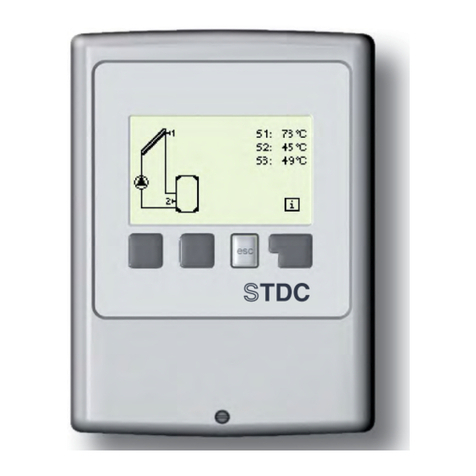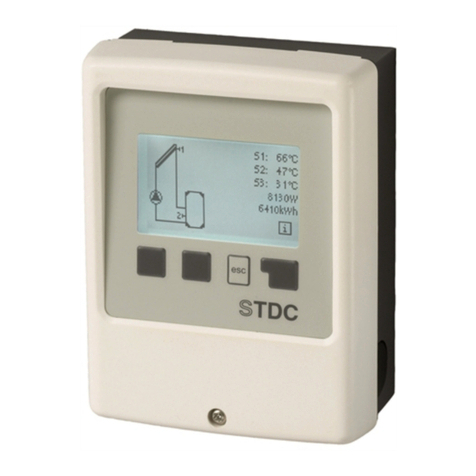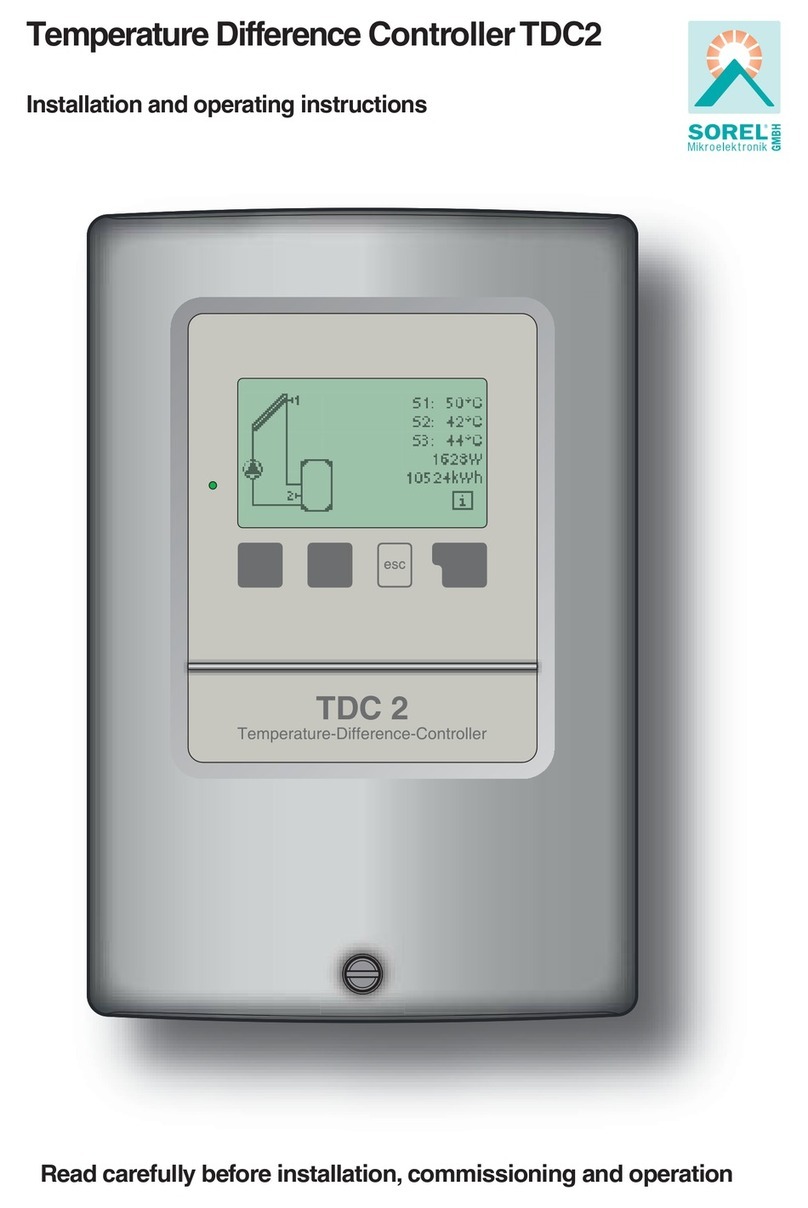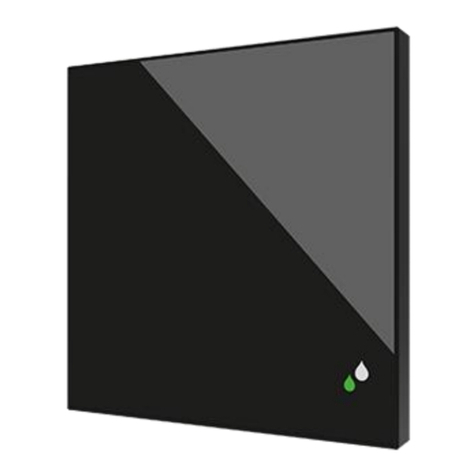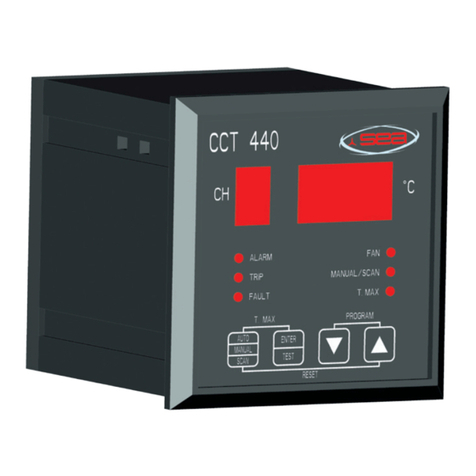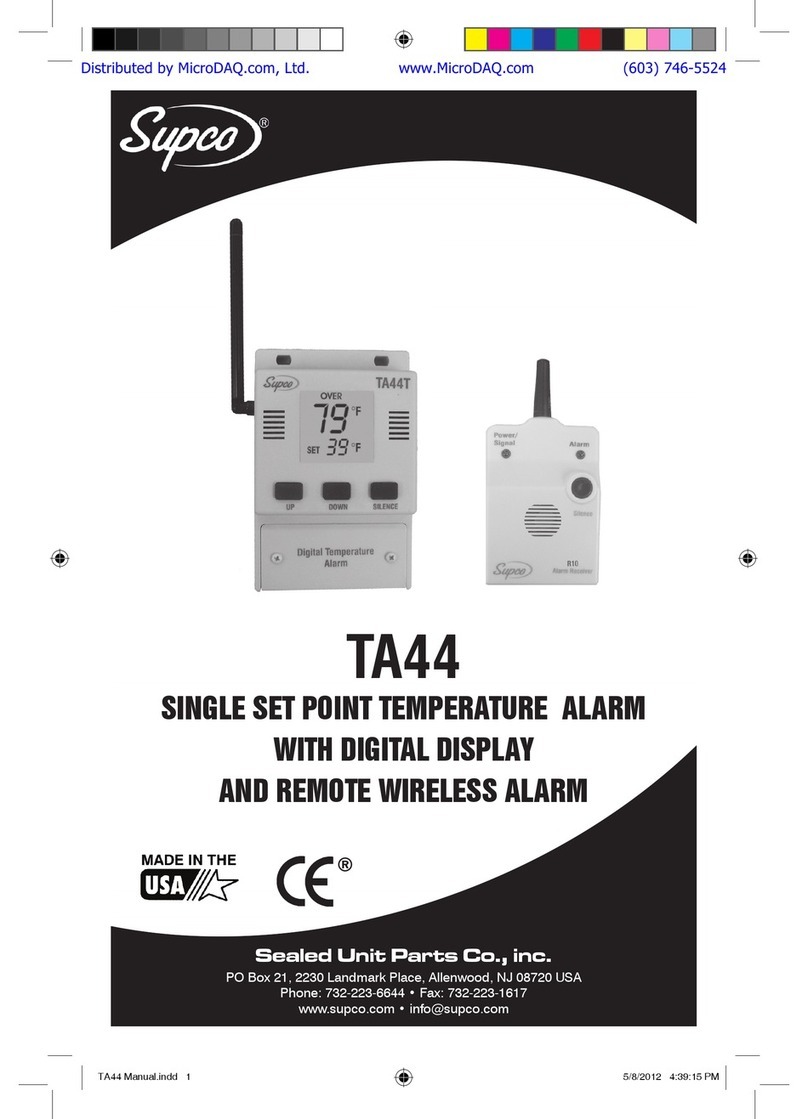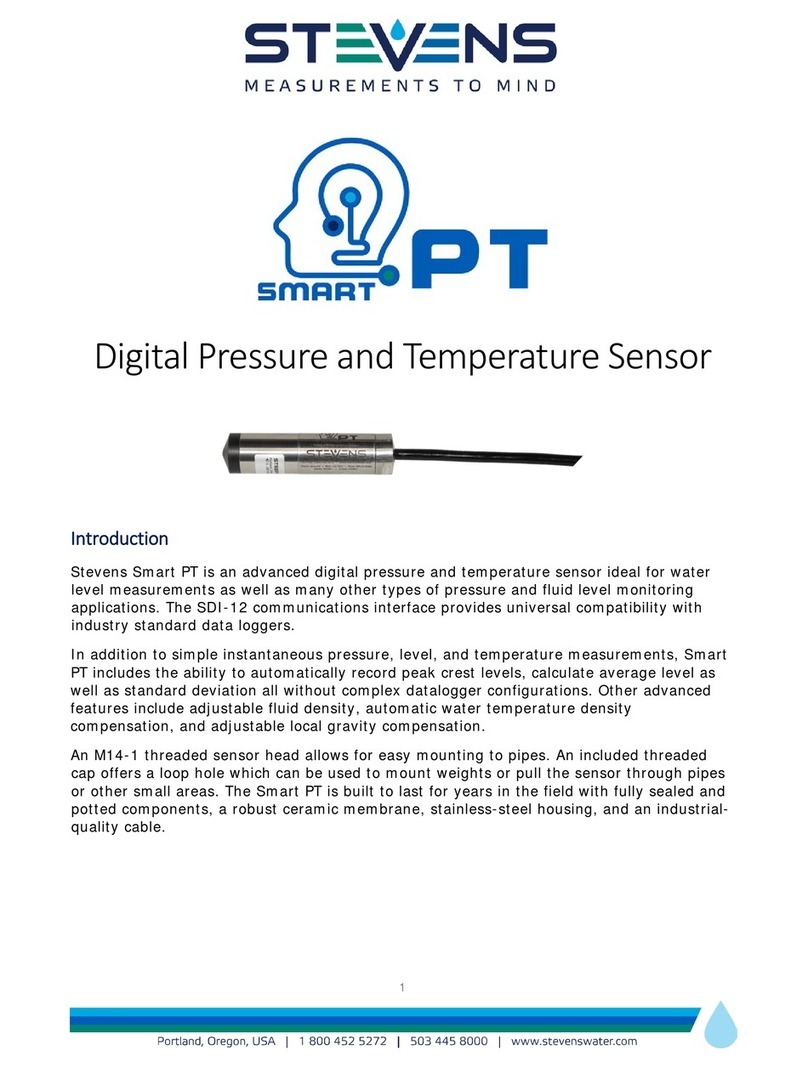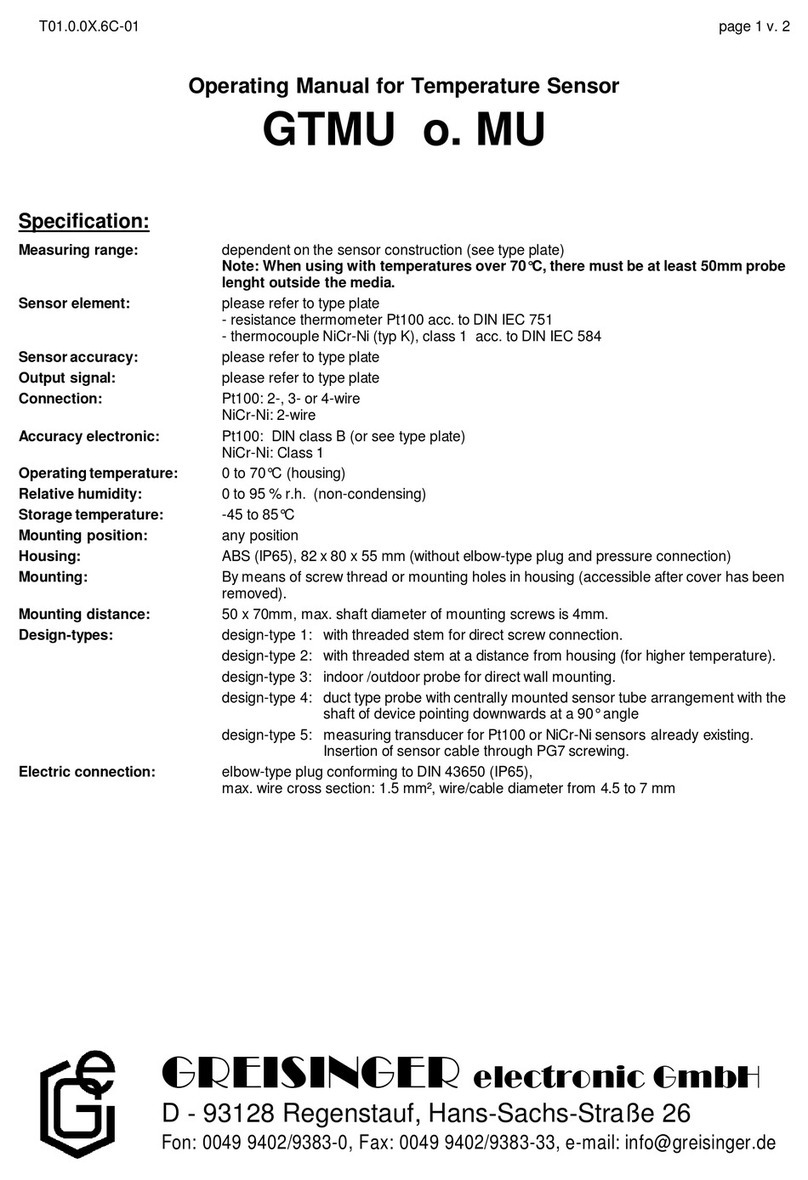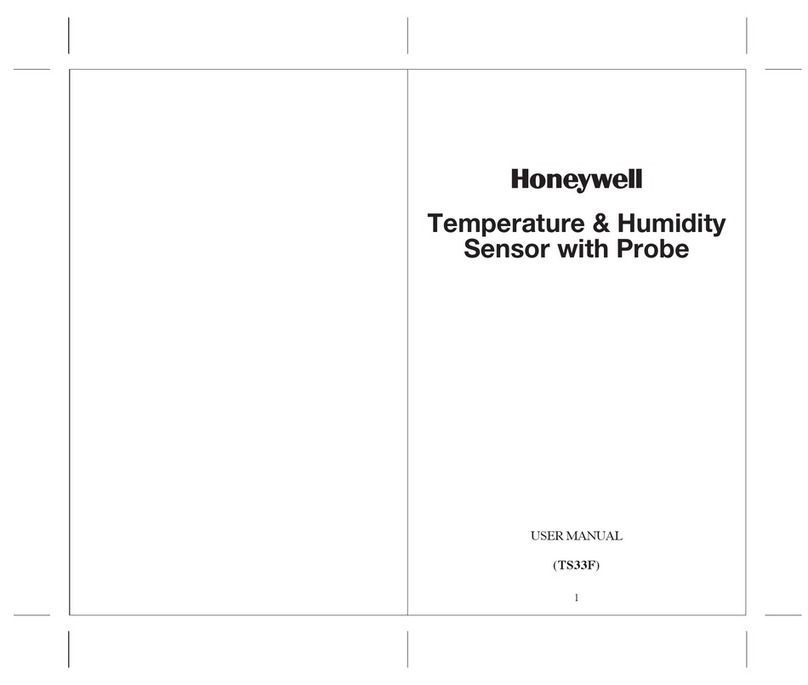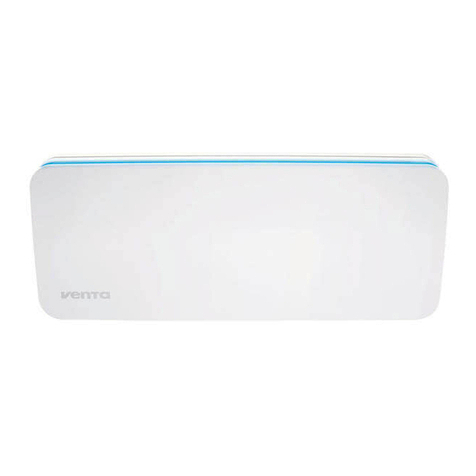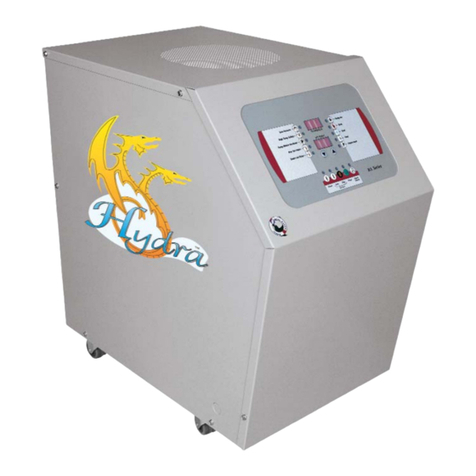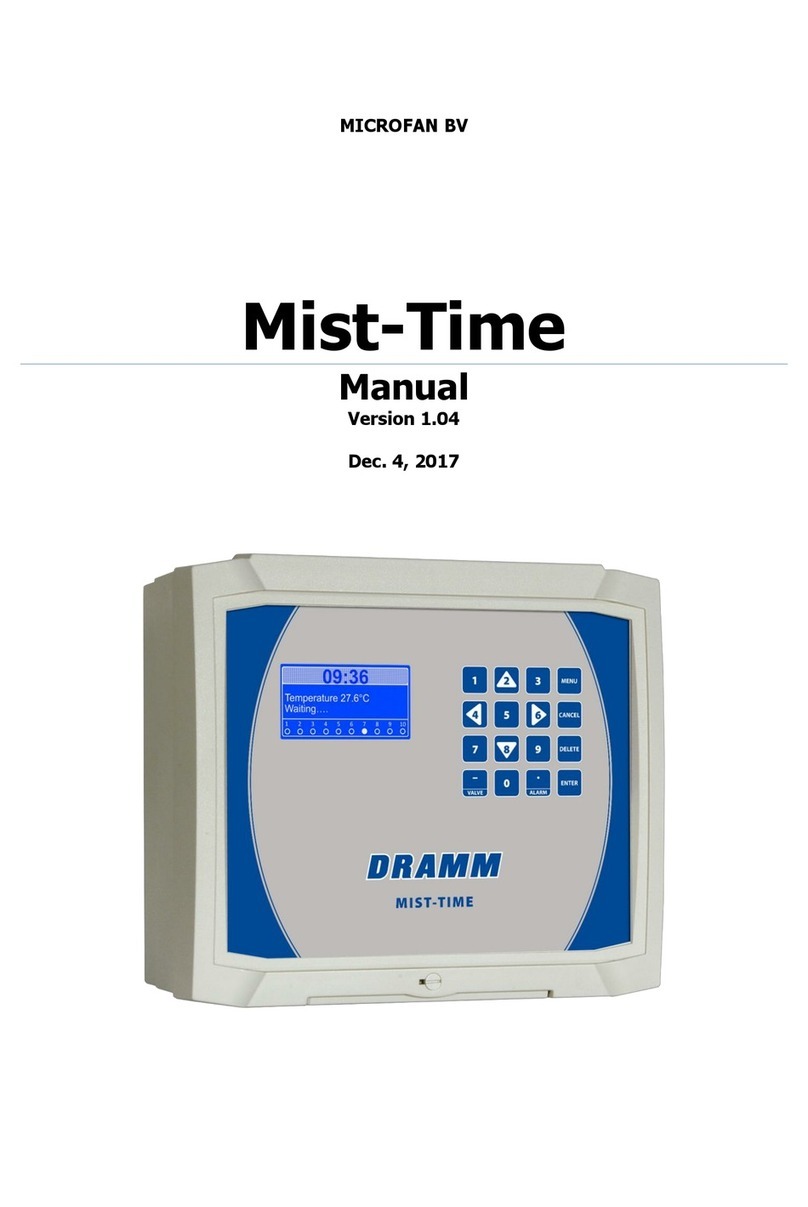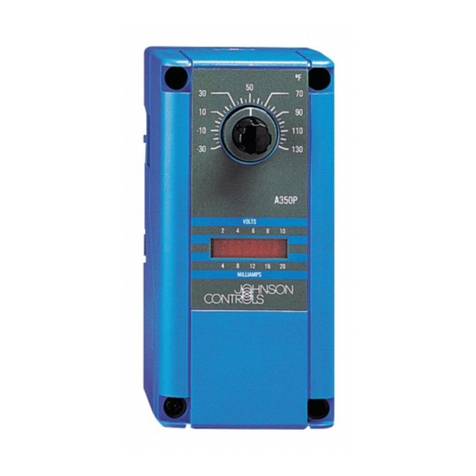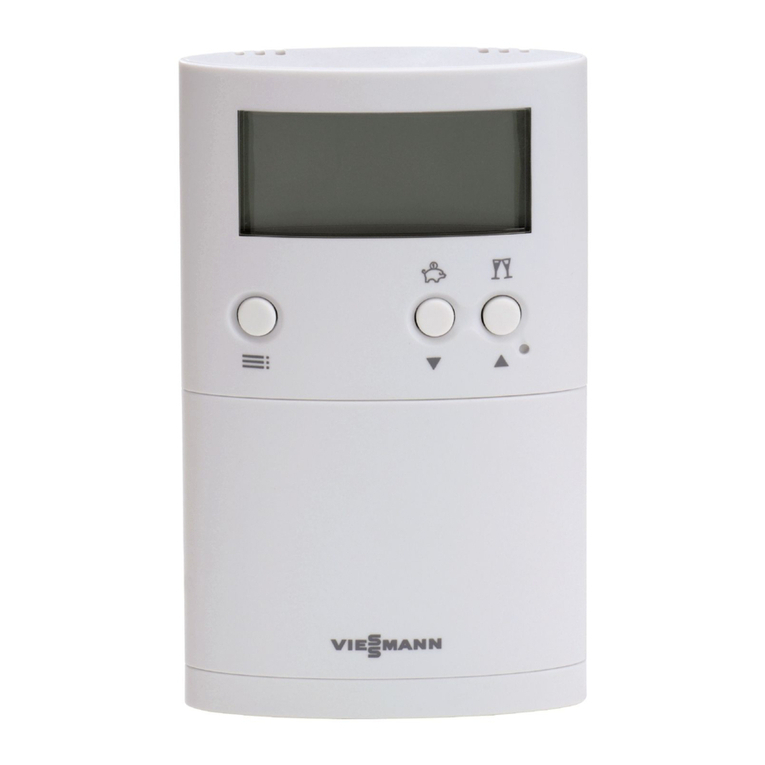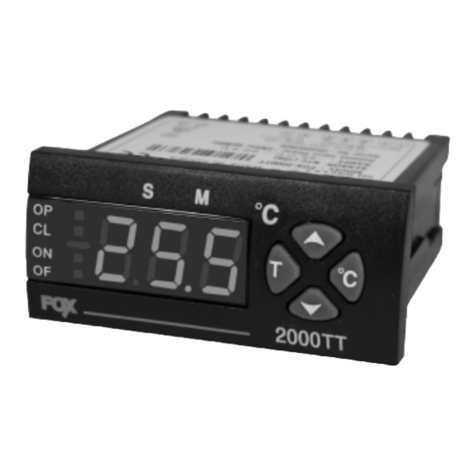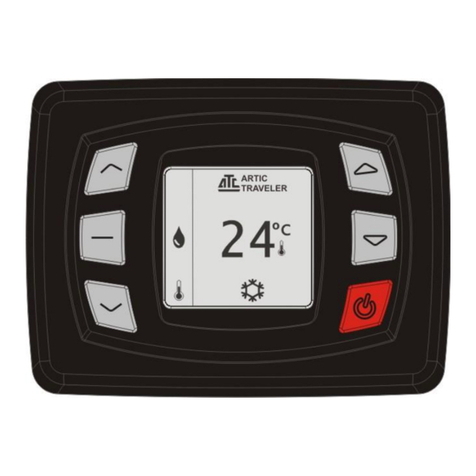Sorel TDC 2 User manual

1
Temperature Difference Controller TDC 2
Installation and operating instructions
Read carefully before installation, commissioning and operation

2
Contents
Description of controller
2.1 Specifications
2.2 About the controller
2.3 Scope of supply
2.4 Disposal of pollutants
2.5 Hydraulic variants
2
5
6
6
6
7
Operation
4.1 Display and input
4.2 Menu sequence
4
12
13
Parametrisation
5.1 Commissioning help
5.2 Free commissioning
5
14
14
Malfunctions/maintenance
16.1 Error messages
16.2 Replacing the fuse
16.3 Maintenance
16
32
33
33
N
Installation
3.1 Wall installation
3.2 Electrical connection
3.3 Installing the sensors
3
8
9-10
11
Protective functions menu 6
11.1 Seizing protection
11.2 Frost protection
11.3 Solar protection
11.4 Recooling
11.5 Anti-Legionella
11
22
22
23
24
24
Special functions menu 7
12.1 Program selection
12.2 Time & date
12.3 Sensor calibration
12.4 Commissioning
12.5 Factory settings
12.6 Expansions
12.7 Heat quantity
12.8 Start help
12.9 Speed control
12
25
25
25
26
26
26
26
27
28
Useful notes
17 34
Chapter Page Chapter Page
Measurement val. menu 1
615
Statistics menu 2
7.1 Operating hours
7.2 Average ΔT
7.3 Heat output
7.4 Graphic overview
7.5 Error messages
7.6 Reset/clear
7
16
16
16
16
16
16
Settings menu 5
10.1 Tmin S1
10.2 Tmax S2
10.3 ΔT R1
10.4 TrefS3
10.5 Hysteresis
10.6 Energy saving mode
10.7 TminS3
10.8 Thermostat periods
10.9 „Party function“
10
19
19
19
20
20
20
20
21
21
Menu lock menu 8 30
13
Language menu10
14 30
Service values menu 9
15 31
Safety instructions
1.1 EC conformity
1.2 General instructions
1.3 Explanation of symbols
1.4 Changes
1.5 Warranty
1
3
3
3
4
4
Display mode menu 3
8.1 Schematic
8.2 Overview
8.3 Alternating
8
17
17
17
Operating modes menu 4
9.1 Automatic
9.2 Manual
9.3 Off
9
18
18
18

3
1.1 EC declaration of conformity
By affixing the CE mark to the unit the manufacturer declares that the TDC 2
conforms to the following relevant safety regulations:
- EC low voltage directive
73/23/EEC, as amended by 93/68/EEC
- EC electromagnetic compatibility directive
89/336/EEC version 92/31/EEC version 93/68/EEC
Conformity has been verified and the corresponding documentation and
the EC declaration of conformity are kept on file by the manufacturer.
1.2 General instructionsIt is essential that you read this!
These installation and operating instructions contain basic instructions and
important information regarding safety, installation, commissioning,
maintenance and the optimal use of the unit. Therefore these instructions
must be read completely and understood by the installation technician/
specialist and by the system user before installation, commissioning and
operation of the unit.
The valid accident prevention regulations, VDE regulations, the regulations
of the local power utility, the applicable DIN-EN standards and the installation
and operating instruction of the additional system components must also
be observed. The controller does not under any circumstances replace
any safety devices to be provided by the customer!
Installation, electrical connection, commissioning and maintenance of the
unit may only be carried out by specialists who possess the appropriate
training.
For the user: Make sure that the specialist gives you detailed information
on the function and operation of the controller. Always keep these
instructions in the vicinity of the controller.
1.3 Explanation of symbols
Failure to observe these instructions can result in danger to life
from electric voltage.
Danger
Danger
Failure to observe these instructions can result in serious damage
to health such as scalding, or even life-threatening injuries.
Caution
Failure to observe these instructions can result in destruction of
the unit or the system, or damage to the environment.
Caution
Information which is especially important for the function and op-
timal use of the unit and the system.
Safety instructions
1 1

4
Safety instructions
1 1
1.4 Changes to the unit
1.5 Warranty and liability
The controller has been manufactured and tested with regard to high quality
and safety requirements. The unit is subject to the statutory guarantee period
of two years from the date of sale.
The warranty and liability shall not include, however, any injury to persons or
material damage that is attributable to one or more of the following causes:
- Failure to observe these installation and operating instructions
- Improper installation, commissioning, maintenance and operation
- Improperly executed repairs
- Unauthorised structural changes to the unit
- Installation of additional components that have not been tested
together with the unit
- Any damage resulting from continued use of the unit despite an
obvious defect
- Failure to use original spare parts and accessories
- Use of the device for other than its intended purpose
- Operation above or below the limit values listed in the
specifications
- Force majeure
- Changes, additions to or conversion of the unit are not permitted
without the written permission from the manufacturer
- It is likewise forbidden to install additional components that have not
been tested together with the unit
- If it becomes clear that safe operation of the unit is no longer possible,
for example because of damage to the housing, then turn the controller
off immediately
- Any parts of the unit or accessories that are not in perfect condition
must be exchanged immediately
- Use only original spare parts and accessories from the manufacturer.
- Markings made on the unit at the factory must not be altered,
removed or made illegible
- Only the settings actually described in these instructions may be made
on the controller
Danger
Changes to the unit can compromise the safety and function of the
unit or the entire system.

5
Description of controller
2 2
2.1 Specifications
Electrical specifications:
Mains voltage 230VAC +/- 10%
Mains frequency 50...60Hz
Power consumption 2VA
Switched power
Electronic relay R1 min.20W...max.120W for AC3
Internal fuse 2A slow-blow 250V
Protection category IP40
Protection class II
Sensor inputs 3 x Pt1000
Measuring range -40°C up to 300°C
Permissible ambient conditions:
Ambient temperature
for controller operation 0°C...40°C
for transport/storage 0°C...60°C
Air humidity
for controller operation max. 85% rel. humidity at 25°C
for transport/storage no moisture condensation permitted
Other specifications and dimensions
Housing design 2-part, ABS plastic
Installation methods Wall installation, optionally panel installation
Overall dimensions 163mm x 110mm x 52mm
Aperture installation
dimensions 157mm x 106mm x 31mm
Display Fully graphical display, 128 x 64 dots
Light diode Multicolour
Operation 4 entry keys
Temperature sensors: (may not be included in the scope of supply)
Collector or boiler sensor Pt1000, e.g. immersion sensor TT/S2 up to 180°C
Storage tank sensor Pt1000, e.g. immersion sensor TT/P4 up to 95°C
Pipe-mounted sensor
Pt1000, e.g. pipe-mounted sensor TR/P4 up to 95°C
Sensor leads 2x0.75mm² extendable up to 30m max.
Temperature resistance table for Pt1000 sensors
°C 0 10 20 30 40 50 60 70 80 90 100
Ω 1000 1039 1077 1116 1155 1194 1232 1270 1308 1347 1385

6
2.2 About the controller
The Temperature Difference Controller TDC 2 facilitates efficient use and
function control of your solar or heating system. The device is impressive
most of all for its functionality and simple, almost self-explanatory operation.
For each step in the input process the individual entry keys are assigned to
appropriate functions and explained. The controller menu contains
headwords for the measured values and settings, as well as help texts or
clearly-structured graphics.
The TDC 2 can be used as a temperature difference controller for the various
system variants illustrated and explained under 2.5.
Important characteristics of the TDC 2:
- Depiction of graphics and texts in a lighted display
- Simple viewing of the current measurement values
-
Analysis and monitoring of the system by means of statistical graphics,etc.
- Extensive setting menus with explanations
- Menu block can be activated to prevent unintentional setting changes
- Resetting to previously selected values or factory settings
- A wide range of additional functions are available and/or planned
Description of controller
2 2
2.3 Scope of supply
- Temperature Difference Controller TDC 2
- 3 screws 3,5x35mm and 3 plugs 6mm for wall installation
- 6 strain relief clips with 12 screws, replacement fuse 2A slow-blow
- Installation and operating instructions TDC 2
Optionally contained depending on design/order:
- 2-3 PT1000 temperature sensors and immersion sleeves
Additionally available:
- Pt1000 temperature sensor, immersion sleeves, overvoltage protection,
- Various additional functions by means of supplementary circuit boards
2.4 Disposal and pollutants
The unit conforms to the European RoHS directive 2002/95/EC for the
restriction of the use of certain hazardous substances in electrical and
electronic equipment.
Caution
The unit must not under any circumstances be disposed of with
ordinary household refuse. Dispose of the unit only at appropriate
collection points or ship it back to the seller or manufacturer.

7
Description of controller
2 2
2.5 Hydraulic variants
The following illustrations should be viewed only as schematic
diagrams showing the respective hydraulic systems, and do not
claim to be complete. The controller does not replace safety devices
under any circumstances.
Depending on the specific application, additional system components and
safety components may be mandatory, such as check valves, non-return
valves, safety temperature limiters, scalding protectors, etc., and must
therefore be provided.
Caution
1 2 (uni-ΔT Controller)
ΔT
3

8
3.1 Wall installation
Installation
3 3
Caution
Install the controller only in dry areas and under the ambient
conditions described under 2.1 “Specifications”. Carry out the
following steps 1-8.
A
Fig.3.1.1
Fig.3.1.2
1.Unscrew cover screw completely
2.Carefully pull upper part of
housing from lower part.
3.Set upper part of housing aside,
being sure not to touch the
electronics when doing so.
4.Hold the lower part of the hous-
ing up to the selected position and
mark the 3 mounting holes.
Make sure that the wall surface is
as even as possible so that the
housing does not become
distorted when it is screwed on.
5.Using a drill and size 6 bit, drill
3 holes at the points marked
on the wall and push in the plugs.
6.Insert the upper screw and screw
it in slightly.
7.Fit the upper part of the housing
and insert the other two screws.
8. Align the housing and tighten the
three screws.

9
Installation
3 3
3.2 Electrical connection
Before working on the unit, switch off the power supply and secure
it against being switched on again! Check for the absence of power!
Electrical connections may only be made by a specialist and in
compliance with the applicable regulations.
Do not use the controller if the housing shows visible damage.
Caution
Danger
Low-voltage cables such as temperature sensor cables must be
routed separately from mains voltage cables.
Feed temperature sensor cables only into the left-hand side of the
unit, and mains voltage cables only into the right-hand side.
Caution
Caution
Fig.3.2.1
Caution
The customer must provide an all-pole disconnecting device, e.g. a
heating emergency switch.
The cables being connected to the unit must not be stripped by
more than 55mm, and the cable jacket must reach into the housing
just to the other side of the strain relief.
Relay R1 is only suitable for standard pumps (20-120VA) which are
speed-controlled viathe controller. The internal wiring of the controller
is such that residual currents flow over relay R1 even in the rest
condition. Therefore under no circumstances may valves, contactors
or other consumers with low power consumption be operated on
this output. 1.Select necessary program/
hydraulics (Fig. 3.2.2-3.2.3)
2.Open controller as described
under 3.1.
3.Strip cables by 55mmmax.,
insert, fit the strain relief devices,
strip the last 8-9mm of the wires.
(Fig. 3.2.1)
4.Open the terminals using a suit-
able screwdriver (Fig. 3.2.1) and
make electrical connections on
the controller (Page 10)
5.Refit upper part of housing and
fasten with screw.
6.Switch on mains voltage and
place controller in operation.

10
Installation
3 3
3.2 Electrical connection (continued)
Terminal connection diagram, program 2
Fig. 3.2.3 „Universal ΔT controller“
Fig. 3.2.2 “Solar with storage tank“
Terminal connection diagram, program 1
Low voltage max. 12VAC/DC
connection in the left-hand terminal
compartment!
Terminal: Connection for:
S1 (2x) Sensor 1 collector
S2 (2x) Sensor 2 storage tank
S3 (2x) Sensor 3 (optional)
The polarity of the sensors is freely
selectable.
Sensor side
max. 12V
Danger
Caution
Mains side
230VAC
Caution
Options for sensor 3:
display, Tmax function,
heat metering (see 12.7)
Mains voltages 230VAC 50-60Hz
Connection in the right-hand terminal
compartment!
Terminal: Connection for:
L Mains phase conductor L
N Mains neutral conductor N
R1 Pump L (speed)
N Pump N
The PE protective conductor must
be connected to the PE metal terminal
block!
Relay R1: For speed control of
standard pumps, minimum load 20VA
Low voltage max. 12VAC/DC
connection in the left-hand terminal
compartment!
Terminal: Connection for:
S1 (2x) Sensor 1 (control)
S2 (2x) Sensor 2 (reference)
S3 (2x) Sensor 3 (thermostat)
The polarity of the sensors is freely
selectable.
Relay R1: Only for speed
control of standard pumps,
minimum load 20VA
Mains voltages 230VAC 50-60Hz
Connection in the right-hand terminal
compartment!
Terminal: Connection for:
L Mains phase conductor L
N Mains neutral conductor N
R1 Pump L (speed)
N Pump N
The PE protective conductor must be
connected to the PE metal terminal
block!
Sensor side
max. 12V
Danger
Caution
Mains side
230VAC
Brief description of switching function:
The ΔT function sensor 1 > sensor 2
switches the pump to relay R1.
Caution

11
3.3 Installing the temperature sensors
The temperature sensor cables must be routed separately from mains
voltage cables, and must not, for example, be routed in the same
cable duct!
Caution
The controller operates with Pt1000 temperature sensors which are accurate
to the degree, thus ensuring optimal control of system
functions.
Caution
If desired the sensor cables can be extended to a maximum of 30m
using a cable with a cross-section of at least 0.75mm². Make sure
that there is no contact resistance!
Position the sensor precisely in the area to be measured!
Only use immersion, pipe-mounted or flat-mounted sensor suitable
for the specific area of application with the appropriate permissible
temperature range.
Installation
Terminal connection diagram, program 3
Fig. 3.2.4 „Solar with add. heating“
Low voltage max. 12VAC/DC
connection in the left-hand terminal
compartment!
Terminal: Connection for:
S1 (2x) Sensor 1 collector
S2 (2x) Sensor 2 storage tank
S3 (2x) Sensor 3 thermostat
The polarity of the sensors is freely
selectable.
Relay R1: Only for speed
control of standard pumps,
minimum load 20VA
Mains voltages 230VAC 50-60Hz
Connection in the right-hand terminal
compartment!
Terminal: Connection for:
L Mains phase conductor L
N Mains neutral conductor N
R1 Pump L (speed)
N Pump N
R2 additional heating L
N additional heating N
The PE protective conductor must be
connected to the PE metal terminal
block!
Sensor side
max. 12V
Danger
Caution
Mains
side
230VAC
Caution

12
Operation
4 4
4.1 Display and input
The display (1), with its extensive text
and graphics mode, is almost self-
explanatory, allowing easy operation
of the controller.
The LED (2) lights up green when a
relay is switched on.
The LED (2) lights up red when
operating mode “Off”is set.
The LED (2) flashes slowly red in the
operating mode “Manual”.
The LED (2) flashes quickly
red when an error is present.
Entries are made using four keys
(3+4), which are assigned to different
functions depending on the situation.
The “esc”key (3) is used to cancel
an entry or to exit a menu. If
applicable there will be a request for
confirmation as to whether the
changes which have been made
should be saved.
The function of each of the other
three keys (4) is shown in the display
line directly above the keys; the right-
hand key is generally has a
confirmation and selection function.
Examples of key functions:
+/- = enlarge/shrink values
/ = scroll menu down/up
yes/no = approve/reject
Info = additional information
Back = to previous screen
ok = confirm selection
Confirm = confirm setting
Examples of display symbols:
Pump (rotates in operation)
Valve (direction of flow black)
Collector
Storage tank
Temperature sensor
Warning / error message
New information available
Additional heating OFF
Additional heating ON
(1)
(2)
(3)
(4)

13
Operation
4 4
4.2 Menu sequence and menu structure
The graphics or overview mode
appears when no key has been
press for 2 minutes, or when the
main menu is exited by pressing
“esc“.
Pressing a key in graphics or
overview mode takes you directly to
the main menu. The following menu
items are then available for selection
there:
Current temperature values with
explanations (see 6.)
Function control of the system with
operating hours, etc. (see 7.)
Select graphics mode or overview
mode (see 8.)
Automatic mode, manual mode or
switch unit off (see 9.)
Set parameters needed for normal
operation (see 10.)
Solar and frost protection, recooling,
anti-seizing protection (see 11.)
Program selection, sensor cali-
bration, clock, additional sensor,
etc. (see 12.)
Against unintentional setting chan-
ges at critical points (see 13.)
For diagnosis in the event of an
error (see 14.)

14
Parametrisation
5 5
The first time the controller is turned
on and after the language and time
are set, a query appears as to
whether you want to parametrise the
controller using the commissioning
help or not. The commissioning help
can also be terminated or called up
again at any time in the special
functions menu. The commissioning
help guides you through the
5.1 Commissioning help
Caution
Observe the explanations for the the individual parameters on the
following pages, and check whether further settings are necessary
for your application.
5.2 Free commissioning
If you decide not to use the commissioning help, you should make the
necessary settings in the following sequence:
- Menu 10. Language (see 14.)
- Menu 7.2 Time and date (see 12.2)
- Menu 7.1 Program selection (see 12.1)
- Menu 5. Settings, all values (see 10.)
- Menu 6. Protective functions if adaptations are necessary (see 11.)
- Menu 7. Special functions if additional changes are necessary (see 12.)
necessary basic settings in the correct order, and provides brief descriptions
of each parameter in the display.
Pressing the “esc”key takes you back to the previous value so you can
look at the selected setting again or adjust it if desired. Pressing the “esc“
more than once takes you back step by step to the selection mode, thus
cancelling the commissioning help. Finally, menu 4.2 under operating mode
“Manual”should be used to test the switch outputs with the consumers
connected, and to check the sensor values for plausibility. Then switch on
automatic mode.
Caution
Observe the explanations for the the individual parameters on the
following pages, and check whether further settings are necessary
for your application.
Finally, menu 4.2 under operating mode “Manual“ should be used to test the
switch outputs with the consumers connected, and to check the sensor values
for plausibility. Then switch on automatic mode.

15
The menu “1. Measurement values”
serves to display the currently
measured temperatures.
The menu is closed by pressing “esc”
or selecting “Exit measurement
values”.
Selecting “Info” leads to a brief help
text explaining the measurement
values.
Selecting “Overview” or “esc” exits
the Info mode.
If “Error” appears on the display instead of the measurement value,
then there may be a defective or incorrect temperature sensor.
Caution
Measurement values menu 1
6 6
If the cables are too long or the sensors are not placed optimally, the result
may be small deviations in the measurement values. In this case the display
values can be compensated for by making entries on the controller. Follow
the instructions under 12.3.
What measurement values are displayed depends on the selected program,
the connected sensors and the specific device design.
6. Measurement values
TTTT

16
Statistics menu 2
7 7
7. Statistics
The menu “2. Statistics” is used for
function control and long-term
monitoring of the system.
The submenus described under
7.1-7.6 are available.
The menu is closed by pressing
“esc” or selecting “Exit statistics”.
7.1 Operating hours menu 2.1
Display of operating hours of the solar pump connected to the controller;
various time ranges (day-year) are available.
7.3 Heat output menu 2.3
Display of the average temperature difference between the reference
sensors of the solar system with the consumer switched on.
7.2 Average temperature difference ΔΔ
ΔΔ
ΔT menu 2.2
Display of the heat output of the system. This menu can only be selected,
however, if sensor 3 is installed and the function “Heat quantity” is activated
under 12.7.
7.4 Graphic overview menu 2.4
This provides a clearly-organised display of the data listed under 7.1-7.3
as a bar graph. Various time ranges are available for comparison. The two
left-hand keys can be used to page through the data.
7.5 Error messages menu 2.5
Resetting and deleting the individual analyses. The function “All statistics”
clears all analyses but not the error messages.
7.6 Reset / clear menu 2.6
Display of the last three errors occurring in the system with indication of date
and time.
For analysis of the system data it is essential for the time to be set
accurately on the controller. Please note that the clock does not
continue to run if the mains voltage is interrupted, and must therefore
be reset. Improper operation or an incorrect time may result in data being
deleted, recorded incorrectly or overwritten.
The manufacturer accepts no liability for the recorded data!
Caution

17
Display mode menu 3
8 8
8. Display mode
Menu “3. Display mode” is used to
define the controller’s display for
normal operation.
This display appears whenever two
minutes go by without any key being
pressed. The main menu appears
again when a key is pressed.
The menu is closed by pressing
“esc” or selecting “Exit display
mode”.
8.1 Schematic menu 3.1
In graphics mode, the selected hydraulic systems are depicted with the
measured temperatures and operating states of the connected consumers.
8.2 Overview menu 3.2
In overview mode, the measured temperatures and operating states of the
connected consumers are depicted in text form.
8.3 Alternating menu 3.3
In alternating mode the schematic mode and then the overview mode are
active for 5 seconds at a time.

18
9. Operating mode
In menu “4. Operating modes” the
controller can either be placed in
automatic mode, switched off, or
placed in a manual operating mode.
The menu is closed by pressing “esc”
or selecting “Exit operating modes”.
Operating modes menu 4
9 9
Danger
When operating mode “Manual” is activated, the current
temperatures and the selected parameters are no longer considered.
There is a danger of scalding or serious damage to the system.
.
The operating mode “Manual” may only be used by specialists for brief
function tests or during commissioning!
The relay and thus the connected consumer are switched on and off by
pressing a key, with no regard to the current temperatures and the
parameters which have been set. The measured temperatures are also
shown to provide an overview and function control.
9.2 Manual menu 4.2
9.3 Off menu 4.3
When the operating mode “Off” is activated, all controller functions
are switched off. This can lead, for example, to overheating on the
solar collector or other system components. The measured
Automatic mode is the normal operating mode of the controller.
Only automatic mode provides proper controller function taking into
account the current temperatures and the parameters that have
Caution
been set! After an interruption of the mains voltage the controller
automatically returns to the last operating mode selected!
9.1 Automatic menu 4.1
Caution
temperatures continue to be shown shown to provide an overview.
This special operating mode is intended only for the filling procedure
for a special “Drain Master System” with a fill level contact parallel
to collector sensor S1. The instructions on the display must be followed
when filling the system. Be sure to terminate the function when
finished!
Caution
9.4 Fill system menu 4.4

19
10. Settings
The necessary basic settings
required for the control function are
made in menu “5. Settings”.
Danger
Temperature values which are set too high can lead to scalding or
damage to the system. Scalding protection must be provided by
the customer!
10.1 Tmin S1 menu 5.1 = enable/start temperature at sensor 1
If this value is exceeded at sensor 1 and the other conditions are also met,
then the controller switches the pump on. If the temperature at sensor 1
drops below this value by 5°C, then the pump is switched off again.
Setting range: from 0°C to 99°C/default setting: 20°C
10.2 Tmax S2 menu 5.2 = switch-off temperature at sensor 2
If this value is exceeded at sensor 2 and the other conditions are also met,
then the controller switches the pump off. If sensor 2 falls below this value
again and the other conditions are also met, then the controller switches
the pump on again.
Setting range: from 0°C to 99°C/default setting: 60°C
Settings menu 5
10 10
Caution
This does not under any
circumstances replace
the safety facilities to be
provided by the customer!
The menu is closed by pressing
“esc” or selecting “Exit settings”.
10.3 ΔΔ
ΔΔ
ΔT R1 menu 5.3 = switch-on temperature difference sensor1/sensor2
If this temperature difference between sensor1 and sensor2 is exceeded
and the other conditions are also met, then the controller switches the
pump on. If the temperature difference between sensor1 and sensor2 drops
to 1/3 of this value, then the pump is switched off again.
Setting range: from 4°C to 20°C/default setting: 10°C
Caution
If the set temperature difference is too small, this may result in
ineffective operation, depending on the system and sensor positions.
Special switching conditions apply for speed control (see 12.9)!

20
Settings menu 5
10 10
Caution
The menu items 10.4 to 10.9 only appear when hydraulic variant 3
is selected (see 12.1)
10.4 TrefS3 menu 5.4 = set temperature at sensor 3
If the thermostat function is active (see 10.8) and the temperature falls
below the set temperature, the additional heating at relais 2 is switched on
until the temperature reaches the set value + hysteresis (see 10.5 hysteresis)
Setting range: from 0°C to 99°C/default setting: 50°C
10.5 Hysteresis menu 5.5 =
hysteresis of the thermostat function via S3
By setting the hysteresis value the heating of the storage tank can be
adjusted.If the temperature of the Tsetpoint at sensor 3 is exceeded by the
set hysteresis, additional heating at relais 2 is deactivated. If the Energy
saving mode is active (10.6) the system heats up until TminS3+hysteresis
temperature is reached.
Setting range: from 2°C to 20°C/default setting: 10°C
10.6 Energy saving mode menu 5.6
If active the the additional heating via relais R2 heats up only till
TminS3+hysteresis is reached (see 10.7). If Energy saving mode is active,
but no solar charging takes place, Tsetpoint3 is used instead.
Setting range: on, off/default setting: off
Caution
The menu item TminS3 10.7 only appears when energy saving mode
is active (see 10.6)
10.7TminS3 menu 5.7
=
minimum temperature S3 in Energy saving mode
If the temperature at sensor 3 falls below this value and the thermostat
function is active (see 10.8), additional heating via relais R2 is switched on
until TminS3 + hysteresis is reached (see 10.5).
Setting range: 0°C to 99°C /default setting: 20 °C
10. Settings (continued)
Other manuals for TDC 2
1
Table of contents
Other Sorel Temperature Controllers manuals
